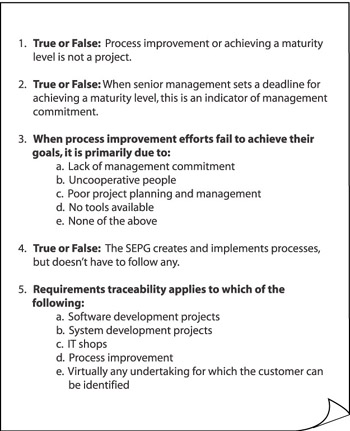Chapter 3: Managing the Process Improvement Project
It is not the same to talk of bulls as to be in the bullring.
” Spanish Proverb
WHAT DO YOU THINK? WHAT DO YOU BELIEVE?
Take a minute and answer the questions in Figure 3.1. Then, once you ve finished reading this chapter, take the quiz in Figure 3.15 ” What Did You Learn? What Will You Do ” to find out how much this information has helped you with your own CMMI-based process improvement. Remember, these quizzes are like process improvement work, there is rarely a right or wrong answer; there are only answers that best suit your organization s business needs.

Figure 3.1: Chapter 3: What Do You Think? What Do You Believe?
This chapter is written primarily for people in the organization who have direct responsibility for planning, leading, tracking, and reporting CMMI-based process improvements. This audience includes members of SEPGs or EPGs, process improvement managers, and the like. There are some tips for executives and senior managers, project managers, and engineers and other technical people.
Here s one of the biggest ironies about the process improvement efforts I ve been involved with. The people responsible for managing the process efforts love to point out when management doesn t walk the talk : managers talk about process improvement, but their actions say otherwise . Yet, how many times have you seen people managing process improvement not practice what they preach?
Here s what I mean: the CMMI process areas REQM, PP, PMC, IPM and RSKM are all about managing requirements and planning and managing system projects, right? So why should the project called process improvement or CMMI implementation be any different? Why do those of us in SEPGs or similar process focus units, the people who are supposed to manage and control process improvement, often not do any of the following?
-
Gather and manage requirements for implementing CMMI
-
Estimate and plan the process improvement efforts
-
Develop a process improvement project plan
-
Conduct regular tracking and oversight of the process improvement project
-
Monitor stakeholder involvement and commitment to the process improvement s success
-
Have someone objectively verify our work against our own plans, standards, and procedures
-
Make sure our process work products are under change or configuration control
-
Peer review our work products
-
Plan integrated team work and collaboration
-
Measure and collect data on the process improvement effort
Why should we manage model-based process improvement any differently than the way we ask system development and engineering managers to manage their projects? The answer is, we shouldn t. If we do, we are hypocrites and not credible to the rest of the organization. Let s take a closer look at how you could (and should) manage your process improvement effort as a project using the same CMMI-based processes you re going to ask the system projects to use.
| |
If you re an executive or senior manager in the organization and you really want the CMMI process improvement effort to succeed, don t treat it any differently than you do other high-priority programs or projects in the organization. Let the people managing the process improvement effort know that you expect to see fact-based estimates and plans (documented) for achieving the process improvement goals. Ask for the same kind of progress, status, and measures that you ask for from other programs or projects. Base your decisions regarding resource allocations to the CMMI project using the same business-based criteria that you use for systems projects.
You ll have to give some also. Realize that demanding a completion date (e.g., achieving a maturity level) for the process improvement project (or for any type of project) that is not based on historical or industry data or fact-based estimates is a low maturity behavior and won t inspire confidence among your people that you really buy into the principles of process discipline. If you timebox the CMMI project because that is how you manage all other projects, accept that you ve increased risk, descoped the deliverables, will have to increase allocated resources, or all three.
Finally, don t allow yourself or others to treat the process improvement project as if it is in addition to the real work. You will hear people grumble things like, I can t do this process stuff because I ve got ˜real work to do. At times, you ll feel the same way. Try very hard to change this view for yourself and others. Improving the way your people work is as much a part of the job as coding, designing, testing, etc.; don t let CMMI or process improvement become extracurricular.
| |
EAN: 2147483647
Pages: 110